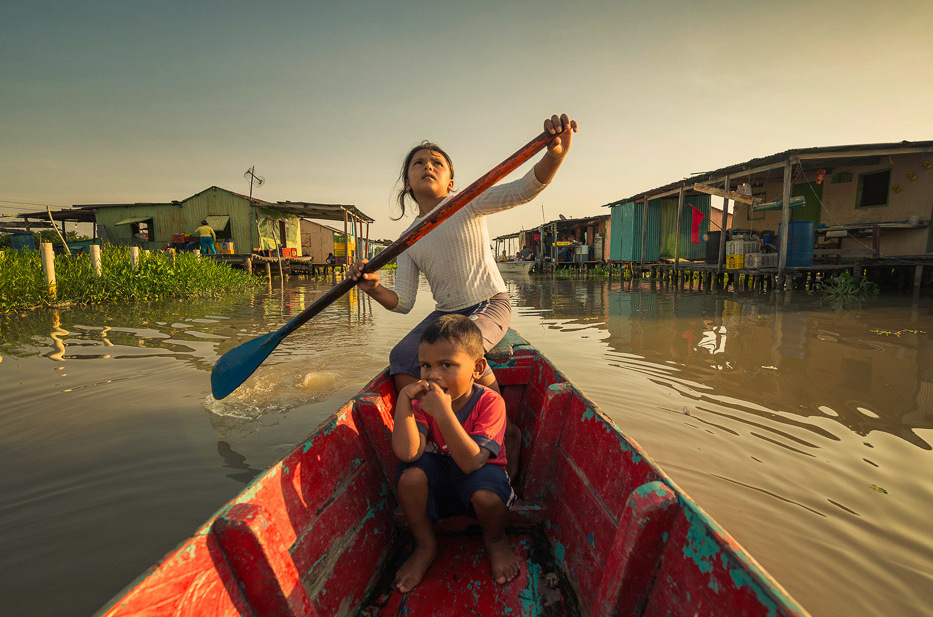In Congo Mirador the floating houses decreased in number, the inhabitants took them away in boats to escape the sedimentation that prevented their daily activities. Today, the village is a ghost of its past; everyone left looking for a better future, for options for themselves and their children.
The place has a particular beauty, with a different style and rhythm of life. The children drive boats, there is only one school and the residents entertain themselves with the election of the local queen and the festivities to saints. The tranquility of its waters contrasts with the power of the Catatumbo Lightning, a natural phenomenon that permanently shows lightning in nearby Lake Maracaibo.
The houses in Congo Mirador are supported on pillars a few meters above the water. The inhabitants have no cars, because the roads are non-existent. They navigate the lake in small boats, while the water, their main resource, recedes every day due to sedimentation and pollution.
For seven years, the film crew of ‘Once Upon a Time in Venezuela’ followed the lives of the peoples of the village of Congo Mirador in southern Lake Maracaibo, a few kilometers from the Caribbean Sea. The film’s director, Anabel Rodríguez Ríos, secured funding from the Tribeca Film Institute to develop the ambitious project. To follow up on the story, the crew traveled two or three times a year.
When production began, the town had 1,000 inhabitants, now there are only five. The village has an enormous oil field at its feet, the largest in Venezuela, but even so, it swims in misery because it has never received any benefit from this wealth.
The documentary shows, through this population, the corruption that exists in the country and the negligence of the politicians. Both sides of the picture are portrayed in a crude way, where struggle and survival are part of the daily life of the residents of Congo Mirador.
‘Once Upon a Time in Venezuela’ exposes the political polarization of Venezuelans. On the one hand, those who support Hugo Chavez’s ‘revolution of the 21st century’, and on the other, those who are against it. Although both try to save their people, the conflicts create insurmountable divisions that do not benefit the future of the community.
The protagonists are Natalie and Tamara, sworn enemies. The first one is the village teacher and opponent of Maduro’s government. A calm woman who tries to save the school, without success. Over the years, she observes the deterioration of the small infrastructure, where she teaches, until the roof disappears. In the end, she packs up her things and moves her house from Congo Mirador.
Tamara, on the other hand, is a loyal follower of Hugo Chávez. She kisses one of the many images of the former President that adorn her house. As a political leader, she performs acts of corruption, such as buying votes, to guarantee the permanence of the ruling party. As a community leader, she tries to get the lake dredged to save her community, but is ignored and humiliated by an important political figure. At that moment, her emotion deflates and she seems to understand that her hometown will die betrayed by those she supports.
The documentary covers the only elections won by the opposition during the last few years. The people of Congo Mirador celebrate the victory for a ‘free Venezuela’ thinking it would represent a change; all Venezuelans thought so. Instead, after the defeat, Maduro installs a parallel constituent assembly, to impose a higher authority than the parliamentarians elected by the people.
In Congo Mirador, current politics is mixed with a reality that looks implausible. ”Once Upon a Time in Venezuela” seems to be taken from a Latin American magical realism story or a fiction of decadence, in the style of Gabriel García Márquez’s ‘One Hundred Years of Solitude’ or Miguel Otero Silva’s ‘Dead Houses’.
The residents use the polluted waters of the lake for bathing, brushing their teeth, cooking and washing. The boys play with oiled turtles and fish early in the morning, while some girls try to reveal themselves to the imminent fate of marriage at age 13 and teenage pregnancy.
There, social inequality is evident, there is sadness, poverty, rootedness, interrupted innocence, migration, joys, lack of opportunities, love of the home, and fear of loneliness. Many of the water villages in the area have disappeared in recent years. The culture of the palafitos inherited from the indigenous people could not be sustained over time due to the neglect from those with power. Demonstrating the dark places a country can reach when control falls into the wrong hands.
A poem closes the documentary, in which they declaim the phrase “My hope is to see you again”, a message for the migrants scattered around the world, who preserve the feeling of belonging to the place where they grew up.

